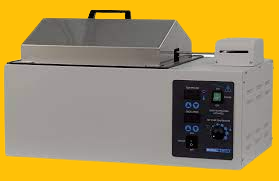A water bath is an equipment that is used to control a steady temperature for a prolonged time when incubating samples. It has more advantages than open flame when heating flammable substances. It has the ability to create some chemical reactions at high temperatures.
It is a container filled with warm water which has different design combinations, sizes, and proportions. The capacity ranges for this instrument are 10 to 30 liters for a standard model and 40 to 100 liters for a large water bath. It may regulate definite temperature for some water baths. It may contain a shaker that is useful for homogenizing the test solution.
This common piece of equipment is mostly used in university labs, environmental research, clinical and microbiology labs, and food technology for warming reagents, sample thawing, corrosion tests, and bacteriological investigations, among other applications. [1]
Principle of Water Bath
This device consists of a sensor that converts the temperature of the water into a resistance value. It is then amplified and compared by an integrated amplifier which produces a control signal. Then it is possible to regulate the average heating power of the electric heating tube and keeps the water at a constant temperature. [2]

Instrumentation of Water Bath
Container
The container of this instrument consists of insulated metal, like stainless steel. Test samples are kept in hot water for a lengthy time in a container.
Container lid
This part of this instrument is made of insulated metal or heat-resistant glass. It keeps the container covered and prevents water evaporation.
Heater
This part helps to create heat in this instrument.
Thermometer
It measures this instrument’s temperature which may be integrated or added on its own.
Thermostat or regulator
It helps to maintain a constant temperature in this instrument.
Propeller or stirrer device
This part of the water bath promotes water circulation inside it.
Outlet
It helps to remove the water from the bath container.
Indicator light
This light helps to maintain the desired temperature if this instrument achieves it. [3]
Types of Water Bath
Shaking type bath
This type of bath has the ability to shake water with high-precision temperature control, a very easy temperature adjustment facility, a precise and clear indication facility, and outstanding and dependable performance. It has the keypad operation, the straightforward bath drains the programmable shaking frequencies, etc.
Circulating type bath
This stirrer type is used for proper circulating water which is useful for numerous applications. It has the ability to circulate water efficiently and dependably obtain and maintain the desired water temperatures required for the cooling or heating of samples and reagents. It is very suitable for enzymatic and serologic testing purposes.
Non-circulating type bath
This type of bath depends on the convection mechanism rather than heating the water uniformly. The control temperature of this bath is less exact than the others. It can add various accessories to stir the water bath to enhance heat transmission in this bath.
Polycarbonate type bath
This type of bath has a controlled heating system and the temperature can reach 100 degrees Fahrenheit. The container of this bath is made of transparent polycarbonate.
Analog and Digital type bath
Analog water bath
This type of bath is simple and affordable. The accuracy of this bath is lower than the digital water baths. The true temperature can’t be shown by this type of water bath.
The working mechanism of analog water bath
Firstly, the power supply must be given and the current will go to the thermostat. Then the current will flow through the water immersion heater and water will start to warm up. The thermostat should be shut off when the water temperature reaches the predetermined level.
Digital water bath
This bath is modern, simple, and extremely pricey. The reading of this water bath is more accurate. The display board of this water bath enables the user to view the real temperature of the bath’s water. [4]
Working Mechanism of digital water bath
It consists solid-state relay (SSR) and PID controller which work combine to manage the water immersion heater. The controller of this bath delivers a certain DC voltage to the relay if the water temperature is below the predetermined value. Then the relay will turn on and cause the AC to flow to the heating rod. After heating the rod, it warms the water. It can be controlled by the PID controller constantly activating and deactivating the relay when the actual temperature of the water approaches the desired value.
Thus it can be possible to get the cycle ON and OFF from the heating rod. The sensor of this device measures the water’s temperature using a resistance temperature detector (RTD). It can convert the temperature to a resistance value, which is supplied to the controller. [5]
Operating Procedure
This device should be cleaned and calibrated to use it for various purposes. Firstly, it must be ensured that the water in the bath has enough depth for the heating element to be poured in. Then turn “ON” the main switch of this bath. It can be possible to set the desired temperature by pressing the SET key. It can change the temperature by pressing any or both of these buttons. You can able to confirm the temperature with a calibrated thermometer. The temperature sensor helps to retain the set temperature whenever a water bath is used. You must be switched “OFF” the main power after the use of this device. It must be kept dry and clean after use.
Applications
This device is very important for various fields because it is used for reagent warming, substrate melting, or cell culture incubation. This bath is a very suitable heating source for heating flammable compounds because it allows some chemical processes to occur at high temperatures. It helps to soluble the poorly soluble compounds.
References
1.https://www.labkafe.com/blog/how-to-use-water-bath-in-laboratory-working-principal-types-maintenance
2.https://microbenotes.com/water-bath-definition-principle-parts-types-procedure-uses/
3.https://microbiologynote.com/laboratory-hot-water-bath-working-principle/
4.https://microbeonline.com/water-bath-parts-principle-and-applications/
5.https://edulab.com/how-to-use-a-water-bath-in-a-laboratory-everything-you-need-to-know/

